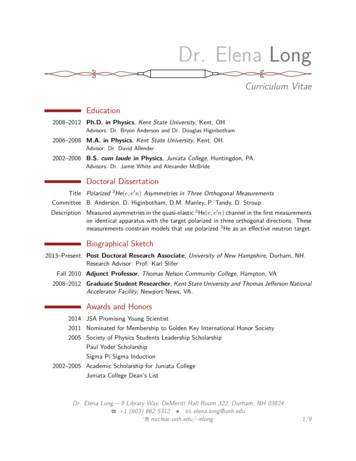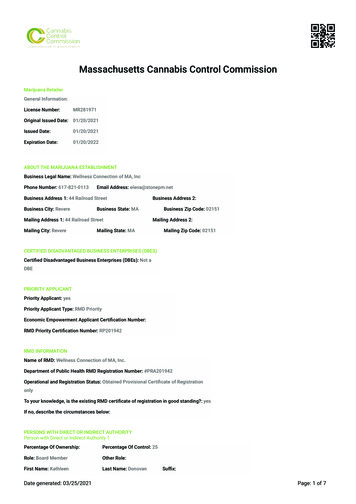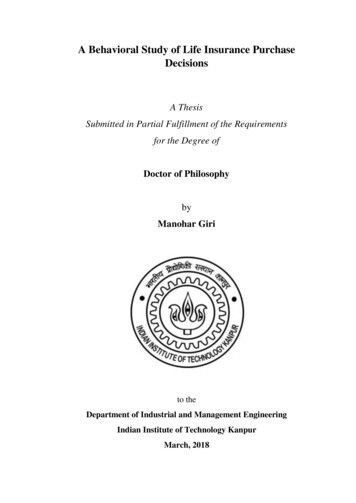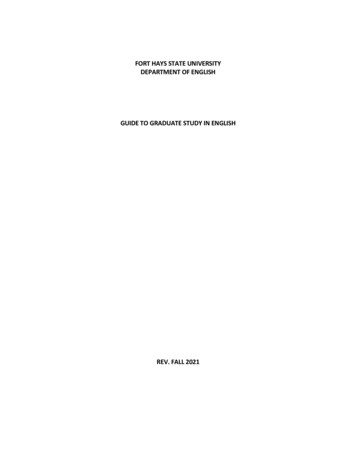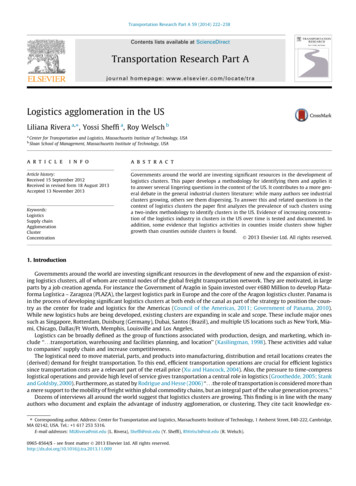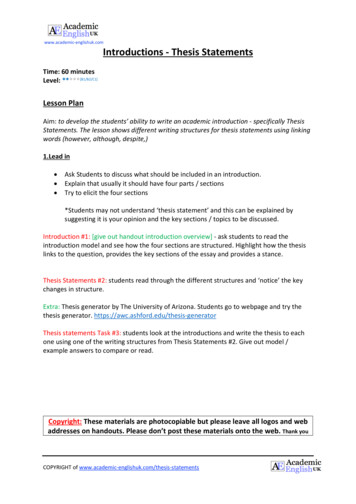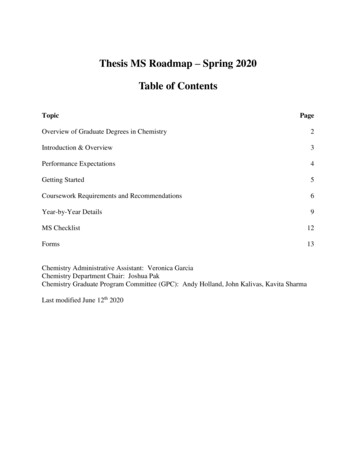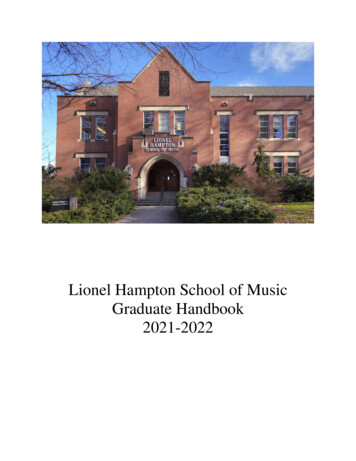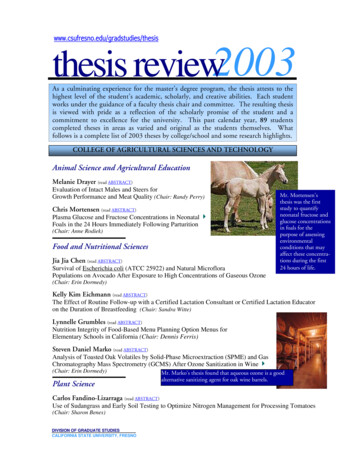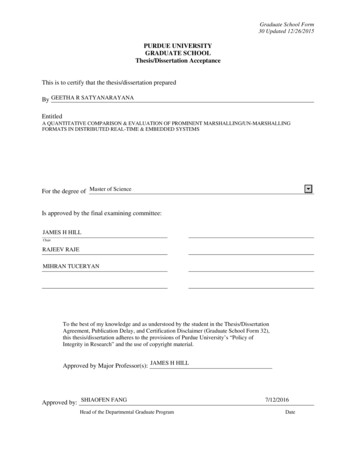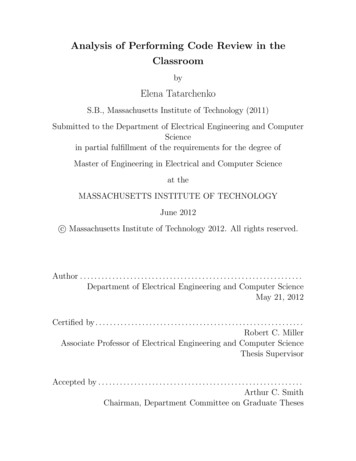
Transcription
Analysis of Performing Code Review in theClassroombyElena TatarchenkoS.B., Massachusetts Institute of Technology (2011)Submitted to the Department of Electrical Engineering and ComputerSciencein partial fulfillment of the requirements for the degree ofMaster of Engineering in Electrical and Computer Scienceat theMASSACHUSETTS INSTITUTE OF TECHNOLOGYJune 2012c Massachusetts Institute of Technology 2012. All rights reserved.Author . . . . . . . . . . . . . . . . . . . . . . . . . . . . . . . . . . . . . . . . . . . . . . . . . . . . . . . . . . . . . .Department of Electrical Engineering and Computer ScienceMay 21, 2012Certified by . . . . . . . . . . . . . . . . . . . . . . . . . . . . . . . . . . . . . . . . . . . . . . . . . . . . . . . . . .Robert C. MillerAssociate Professor of Electrical Engineering and Computer ScienceThesis SupervisorAccepted by . . . . . . . . . . . . . . . . . . . . . . . . . . . . . . . . . . . . . . . . . . . . . . . . . . . . . . . . .Arthur C. SmithChairman, Department Committee on Graduate Theses
2
Analysis of Performing Code Review in the ClassroombyElena TatarchenkoSubmitted to the Department of Electrical Engineering and Computer Scienceon May 21, 2012, in partial fulfillment of therequirements for the degree ofMaster of Engineering in Electrical and Computer ScienceAbstractIn real-world software development, engineering teams generally engage in code reviewto ensure the authorship of high-quality code. However, in undergraduate universitysettings, where many students are preparing for a career in software development,code that is written for classes generally does not go through similar code reviewprocesses. There are many aspects of the academic setting which does not allowexisting commercial code review processes to be used. This work presents a softwaresolution to code reviewing in academic settings, so that students can get constructivecomments about the code they turn in for assignments. The software was used in twosemesters of the Software Engineering course at MIT, and experimental results showthat students can generate high-quality feedback for code written by their classmates.Thesis Supervisor: Robert C. MillerTitle: Associate Professor of Electrical Engineering and Computer Science3
4
AcknowledgmentsI would like to thank my advisor, Rob Miller, who provided much advice, guidance,and insight throughout my research. He allowed me to explore my own ideas whilestill keeping me on track. He constantly inspired me to work harder and to come upwith new and innovative solutions.A special thanks goes to Mason Tang who started this project. He had a visionof code review being used in the classroom and that inspired my work on this thesis.He passed on to me a functional, well written system that I could apply to 6.005 andrun experiments.I would also like to thank both the Fall and Spring 6.005 staff for allowing this toolto be used and being patient with it when it did not perform to its full potential. Asusers of the system you also offered me feedback that was especially valuable. Thankyou for making the tool a success.Finally I would like to thank my friends and family for being supportive when Iwas working on this project. Thank you for tirelessly listening to my problems andbrainstorming solutions. Some of you went well beyond your duties and helped medebug code, participate in code review, and even edit this thesis.5
6
Contents1 Introduction131.1Mechanics of Assigning Code to Review . . . . . . . . . . . . . . . . .141.2Experiment Setup . . . . . . . . . . . . . . . . . . . . . . . . . . . . .151.2.1Chunk Size . . . . . . . . . . . . . . . . . . . . . . . . . . . .151.2.2Chunk Filtering . . . . . . . . . . . . . . . . . . . . . . . . . .161.2.3Task Routing Interface . . . . . . . . . . . . . . . . . . . . . .17Outline . . . . . . . . . . . . . . . . . . . . . . . . . . . . . . . . . . .171.32 Code Review in 6.005212.1The Interface . . . . . . . . . . . . . . . . . . . . . . . . . . . . . . .212.2Workflow . . . . . . . . . . . . . . . . . . . . . . . . . . . . . . . . .232.36.005 . . . . . . . . . . . . . . . . . . . . . . . . . . . . . . . . . . . .242.4Participants of Code Review . . . . . . . . . . . . . . . . . . . . . . .263 Related Work293.1Code Review Systems. . . . . . . . . . . . . . . . . . . . . . . . . .293.2Defect Rates . . . . . . . . . . . . . . . . . . . . . . . . . . . . . . . .303.3Variations in Code Review . . . . . . . . . . . . . . . . . . . . . . . .304 Selecting Chunk Size334.1Motivation . . . . . . . . . . . . . . . . . . . . . . . . . . . . . . . . .344.2Results . . . . . . . . . . . . . . . . . . . . . . . . . . . . . . . . . . .374.2.138Examples . . . . . . . . . . . . . . . . . . . . . . . . . . . . .7
4.2.2Data . . . . . . . . . . . . . . . . . . . . . . . . . . . . . . . .384.2.3Potential Shortcomings . . . . . . . . . . . . . . . . . . . . . .415 Chunk Filtering435.1Partitioning . . . . . . . . . . . . . . . . . . . . . . . . . . . . . . . .445.2Preprocessing . . . . . . . . . . . . . . . . . . . . . . . . . . . . . . .445.3Changes to Display . . . . . . . . . . . . . . . . . . . . . . . . . . . .455.4Routing Details . . . . . . . . . . . . . . . . . . . . . . . . . . . . . .455.5Routing Based on Branching Depth . . . . . . . . . . . . . . . . . . .505.6Shortcomings . . . . . . . . . . . . . . . . . . . . . . . . . . . . . . .516 Routing Interface536.1Components of the Interface . . . . . . . . . . . . . . . . . . . . . . .536.2Responses to Interface . . . . . . . . . . . . . . . . . . . . . . . . . .557 Conclusion577.1Future Work . . . . . . . . . . . . . . . . . . . . . . . . . . . . . . . .577.2Summary . . . . . . . . . . . . . . . . . . . . . . . . . . . . . . . . .598
List of Figures1-1 Routing interface helping staff calculate how much code will be reviewed. .181-2 Routing interface allowing staff to drag and drop chunks in order of priority. 192-1 Interface for seeing assigned and completed tasks. . . . . . . . . . . .222-2 Interface for leaving a comment. . . . . . . . . . . . . . . . . . . . . . .222-3 Interface for replying to a comment. . . . . . . . . . . . . . . . . . . . .222-4 Summary page displaying list of comments left by a user. . . . . . . .232-5 Feedback Survey used by Caesar. . . . . . . . . . . . . . . . . . . . . .242-6 Path from assignment to code review. . . . . . . . . . . . . . . . . . . .252-7 Interaction between preprocessor and web application. . . . . . . . . . . .264-1 Stacked bar plot of types of comment. . . . . . . . . . . . . . . . . . . .394-2 Bar plot of average number of comments per student. . . . . . . . . . . .405-1 Code section containing student and staff lines. . . . . . . . . . . . . . .465-2 Bar plot showing average number of words and average number of commentsleft by students. . . . . . . . . . . . . . . . . . . . . . . . . . . . . . .485-3 Bar plot of average problem set grades. . . . . . . . . . . . . . . . . . .485-4 Bar plot of review time. . . . . . . . . . . . . . . . . . . . . . . . . . .495-5 Fall versus spring average number of words per student. . . . . . . . . . .505-6 Fall versus spring average number of comments per student. . . . . . . . .516-1 Reviewing interface showing how many chunks can be reviewed. . . . . . .546-2 Reviewing interface showing distribution of student lines. . . . . . . . . .556-3 Reviewing interface for prioritizing chunks. . . . . . . . . . . . . . . . .569
10
List of Tables2.1Problem sets used for 6.005 in Fall 2011 and Spring 2012. . . . . . . .264.1Statistics on comment type for each problem set. . . . . . . . . . . .395.1Results of varying chunk sizes and new routing algorithm. . . . . . .475.2Results of varying chunk sizes and new routing algorithm. . . . . . .4911
12
Chapter 1IntroductionCode review is a process where computer code is inspected by other programmers,with the intention of finding bugs and improving code readability. Code review isnecessary in industry to ensure maintainable code, but has not had widespread adoption in an educational setting. In a large computer science class, there is generally notenough course staff to meticulously review every student’s programming submission.The traditional way in which this problem is solved is to write a suite of automatedtests, so that students can be graded in an efficient manner. However, this methoddoes not expose poor design, stylistic problems, or subtle bugs; it only ensures thata student’s code is generally correct.Prior work done by Mason Tang [15] produced a software system called Caesar.Caesar is a software suite designed to solve the problem of code review in the classroom. The innovation in Caesar is that the code review problem is distributed toboth the students and staff of the course. A part of the grade for any problem set isthat students have to both give reviews for other peoples’ code, as well as address thereviews on their own code. This crowdsourced solution solves the problem of givingstudents constructive feedback, without having to increase the size of the course staff.The work by Tang produced the foundation of Caesar, in that the basic pipeline ofgetting student code into a database was written, and a basic web application thatexposed student code to other students was built.This work is a refinement on top of the existing Caesar project. The ultimate goal13
of a system like Caesar is to maximize the amount of constructive feedback that anystudent gets on their problem set submissions. It is an unexplored problem as to howto best divide student code to optimize it for code reviewing purposes, as well as howto distribute those code chunks to potential reviewers. The primary contribution ofthis work is the development of algorithms and evaluations to try to optimize howstudent and staff time is spent, while producing the most relevant feedback for allsubmitted student code.In addition, the project had never actually been used in a real classroom settingbefore; this work partially describes the process of launching Caesar in two semestersof a software engineering class at MIT. The algorithms for dividing student codewere developed on top of real student submissions in these two semesters, and dataproduced by students using the system is the foundation of the evaluations presentedin this work.1.1Mechanics of Assigning Code to ReviewA critical component of the system is deciding how much and what code should begiven to each reviewer to review. In industry, code typically lives in a repository, andeach code modification is called a commit. Before a commit can occur, a code reviewhappens on that commit[10].However, this is not the paradigm that is generally used in classroom settings.Even though a source control system is provided to students, students generally don’thave the discipline to use it in an effective manner. In addition, student commitsshouldn’t necessarily be graded anyways, since they are merely using it as a wayto store history, and not as a method of submitting working code at each revision.Students turn in one final submission, which is a monolithic set of interdependentfiles. A single assignment may be thousands of lines of code, some of which are staffprovided.If the project is too large, it is infeasible to assign that project to just one reviewer;it would be too much work for one person to do. However, instead of assigning a14
reviewer to an entire submission, we can partition each submission, and group similarsegments of code for each reviewer. Each code segment that Caesar treats as a discreteunit will be referred to as a chunk. A reviewer may be assigned several chunks duringthe reviewing process, and each chunk could be assigned to several reviewers. A chunkthat has been assigned to a reviewer will be referred to as a task. It is the aim of thisproject to figure out what is the best way to create, and then distribute chunks.1.2Experiment SetupCaesar was launched for the Fall 2011 semester of Elements of Software Construction(6.005) class at MIT, and was used through Spring 2012. The class was taught entirelyin Java. During that time, the system was used for a total of 13 problem sets. Fiveof the problem sets that were used in Fall 2011 were also used in Spring 2012. As thealgorithms governing chunk size and routing changed, experiments can be constructedthat observe what effect algorithm changes had on the number of comments that wereentered into the system.Because the project is trying to maximize the number of constructive commentsthat are left to students, part of the evaluation process involves observing whether ornot students truly left constructive comments, or if they were not useful. Althoughthere is no objective way classify comments, a random set of comments was chosento be classified, and observations are made based on how many provided useful inputto the code author.1.2.1Chunk SizeTwo different methods for creating chunks were created, and both were used to breakup real student code. The first idea that was implemented was that a chunk shouldbe a single Java method. This way, the average size of a chunk is small, but therewould be more chunks assigned to each reviewer. The second idea is that chunksshould be entire Java classes. Each reviewer would get fewer chunks to review, buteach would be more substantial.15
This work evaluated the merits of each chunking algorithm by comparing thetype of comments that were entered in the system in Fall 2011. Since the goal of theproject is to maximize the number of constructive comments, we evaluate the successof the system by comparing the total number of constructive comments entered in thesystem under these two settings. The results of this experiment showed that moreconstructive comments were entered when chunks were set to be classes.1.2.2Chunk FilteringIn most cases, there are not enough reviewers for the amount of code that is generated,without giving each reviewer an unfeasible amount of code to review each week. Inaddition, a lot of code that students submit is either provided by the staff as part ofthe assignment, or other boilerplate code that is not necessarily important to review.Another challenge of the system is picking out which chunks need the most attentionfrom reviewers.A component of Caesar is an algorithm to rank chunks for review that prioritizesthe most needy code for review, while not prioritizing uninteresting code. Ideally, ifall the code was reviewed, the chunks that would have received the most commentswould be the ones that the system originally prioritized for reviewing. There are amyriad number of signals that can be used from student code which could serve asan indicator of whether or not that code needs to be reviewed. One signal that wasfound to be useful is branching depth, the amount of conditional statements used ina snippet of code.To evaluate changes to the chunk routing algorithm, a natural experiment wasconducted when the same problem sets were used between Fall and Spring of thesame course. Chunk size was kept constant, and a comparison was made between thenumber of comments made between the two semesters. The results of the experimentshowed that prioritizing chunks based on the number of student lines and branchingdepth was more effective than prioritizing strictly based on number of student lines.16
1.2.3Task Routing InterfaceAnother problem this work tries to address is how to give the staff more controlover what code will be reviewed. Each problem set is inherently different, and boththe chunk size and chunk filtering algorithms should be adaptive to the needs of thecourse staff for any given assignment.To solve this problem, an interface was constructed for visualizing the code inthe system, and for fine tuning the reviewing process for that particular problem set.Figures 1-1 and 1-2 show the components of this interface. The interface helps staffunderstand how many chunks of code will be reviewed. It also lets staff pick whichchunks to select for review, and how they should be prioritized. This adds flexibilityto the system, and lets staff guide the reviewing process for each problem set.1.3OutlineThe remainder of this work explores the algorithms that were developed for Caesar,as well as evaluations of those algorithms using real data. Chapter 2 describes the individual components of Caesar, and how a workflow generally operates in the contextof a course problem set. Chapter 3 explores the related work in code review, as wellas ways that Caesar could be used to tackle other previously mentioned problems.Chapter 4 describes the algorithm and evaluation for choosing chunk size. Chapter 5talks about the algorithms and evaluations for filtering and ranking chunks. Chapter6 shows the interface built for staff that lets them control and tune the chunkingand filtering algorithms. Finally, chapter 7 contains future work that can be done onCaesar, as well a summary of the findings of this work.17
Figure 1-1: Routing interface helping staff calculate how much code will be reviewed.18
Figure 1-2: Routing interface allowing staff to drag and drop chunks in order of priority.19
20
Chapter 2Code Review in 6.0052.1The InterfaceCaesar is an application developed at MIT that solves the problem of code reviewin the classroom. The project was started by Mason Tang in Spring 2011 [15], butnot used by students until Fall 2011. He designed the interface for displaying code,leaving comments on source code, and displaying a dashboard for announcements andtasks.The dashboard is the first page users see when they log onto Caesar. Theirdashboard contains a list of tasks they are asked to complete and a list of tasks thatthey have already completed. Figure 2-1 shows an example of the dashboard the usersees. Each line shows information about the code, such as how many reviewers areassigned to it, and the total number of comments that have already been left.The interface for leaving comments is lightweight and easy to use. To leave acomment, users click and drag over several lines of source code. When they releasethe button, a text field next to their highlighted region appears. Figure 2-2 showsthis in action. Users may also reply to existing comments by clicking on the “reply”button when they are hovering over the comment, as in Figure 2-3. The commentbubbles next to the source code are clickable, and highlight the comment and sourcecode that the comment bubble represents.In addition, there is summary page for each user that displays a list of comments21
Figure 2-1: Interface for seeing assigned and completed tasks.Figure 2-2: Interface for leaving a comment.Figure 2-3: Interface for replying to a comment.22
the user has made for each problem set, as shown in Figure 2-4. Each user may seeeach other user’s summary page. This view may be used by the staff to evaluate howwell the students are performing code reviews, and by other students to get a betteridea of the type of comments their peers and staff are leaving.Figure 2-4: Summary page displaying list of comments left by a user.To encourage feedback from users, Caesar had a link to a survey that asked theusers what they liked, didn’t like, and any encountered problems while using Caesar.This feedback is referred to later in this work as anecdotal evidence of user preferencesafter algorithm changes.2.2WorkflowAlongside Caesar, there is preprocessor that reads in student code and starter code,then uploads partitioned code into a database. The system takes in starter codein order to mark which parts of the code are written by students, and which wereprovided by staff. To start out, the system processes and partitions student code intochunks. Chunk size will be discussed in more detail in Chapter 4.The preprocessor is also responsible for catching basic stylistic mistakes. It doesso by performing static analysis on the code in the form of Checkstyle[2]. Staticanalysis catches stylistic problems in student code such as inconsistent indenting andpoor javadoc usage. This analysis is uploaded to the database and used by the webapplication. The preprocessor and the web application interact as shown in Figure2-7.23
Figure 2-5: Feedback Survey used by Caesar.After the preprocessor is finished, the staff may need to change how many tasks toassign to a reviewer, and choose which tasks to prioritize for review. Chunk filteringwill be discussed in more depth in Chapter 5 and changing the settings to the routingwill be discussed in Chapter 6. Figure 2-6 shows the series of events that occur beforereviewing can open.2.36.005Caesar was built for code review in the classroom, and is being used in the Elementsof Software Construction (6.005) class at MIT. Each semester, there are typicallyfour to eight individual problem sets, where each problem set consists of hundredsof lines of code. Some of the problem sets are templated, where overall design andmethod signatures were done by the staff. Other problems sets were more free-form,and gave students design freedom. The starter code may contain implementations ofalgorithms, or ask students to to come up with their own algorithms. All the code24
Figure 2-6: Path from assignment to code review.is written in Java and each of the of the problem sets have automated tests that arerun to verify the correctness of the code.Fall 2011 and Spring 2011 were structured differently, but all the problem setsusing in Spring were also used in the Fall. Table 2.1 shows a list of problem sets usedin each semester. Fall 2011 had a total of eight problem sets, and each problem sethad to be completed in a week. After the due date, the problem set would be code25
Figure 2-7: Interaction between preprocessor and web application.reviewed using Caesar and graded using automated tests. Once students receivedtheir grades back, they had an opportunity to submit a new version of their problemset, but only if they addressed the code review comments in their new submission.Spring 2012 had a total of five problem sets, but each problem set had a beta and afinal. The beta would be code reviewed and graded using the automated tests. Forthe final version, students were responsible for fixing their mistakes such that theautomated tests would pass, as well as addressing code review comments.Problem eeperjottoTitleIntroductionPi PoetryMidi PianoCalculator ParserBuilding a Sudoku Solver with SATFinding Prime Factors with NetworkingMultiplayer MinesweeperJotto Client GUIFall 2011PS0PS1PS2PS3PS4PS5PS6PS7Spring 2012PS0PS1PS2PS3PS4Table 2.1: Problem sets used for 6.005 in Fall 2011 and Spring 2012.2.4Participants of Code ReviewThe participants of code review in the classroom are not necessarily experts. In oursystem, there are three types of reviewers: students, staff, and alums. Students are themost familiar with the problem set but do not necessarily know good coding practices.Staff are both familiar with the problem set and can judge the quality of the code.Alums have taken the class at some point and in most cases have industry experience.26
Our system attempts to get a diverse set of reviewers for each student’s submission.The hope is that students will know where to look for challenging portions of theproblem set and alums will have enough general knowledge to find design flaws.Students and alums perform the bulk of the reviewing. However, since alumshave limited time to devote to code review, they are only assigned 3 tasks, whilestudents are assigned 10 method-sized chunks or 5 class-sized chunks. After studentsand alums have finished leaving their feedback, staff are assigned 20 method-sizedchunks or 10 class-sized chunks that have already been reviewed by students andalums. Their responsibility is to upvote or downvote reviewer comments, and addtheir own comments if anything was missed.In order to encourage reviewers to read the code they are assigned to review, thesystem requires reviewers to perform at least one action on their assigned chunk. Theaction could either be to upvote or downvote an existing comment or to leave a newcomment. In the case that the reviewer could not find fault with the code, they wereasked to write “#lgtm”, meaning “looks good to me”.27
28
Chapter 3Related Work3.1Code Review SystemsExisting industry code review tool are generally designed to interface with versioncontrol systems, support inviting teammates to participate in code review, and participate in discussion. Such systems include Rietveld [6], Gerrit [3], Github[4], andReview Board[9]. The workflow of these systems is for the developer to initiate acode review. Typically these systems ask the developer to select the code to be reviewed from the set of changes they made, and pick the reviewers they want. Thetools expect users to be familiar with how code reviews work, and how to utilize themeffectively. Also, these systems generally take advantage of version control techniquesand display versioning comments during the code review period.In an academic setting the life of the project is much shorter and versioninginformation may be nonexistent or unhelpful so our system is trying to tackle adifferent problem than the current review systems out there. When designing oursystems we can still try to base the reviewing interface on theirs but our techniquesfor selecting which code to review and who should perform the code review is vastlydifferent.29
3.2Defect RatesAccording to a case study on lightweight code review process at Cisco, “the single bestpiece of advice we can give is to review between 100 and 300 lines of code at a timeand spend 30-60 minutes to review it” [11]. The study also mentions the importanceof filtering out both trivial code and thousand-line blocks of code from the reviewingprocess. Part of their evaluation method looked at the defect density for code, butthey did not have any conclusive expectations for what that number should be.Defect rate is a widely discussed topic. We can define a defect as a variation ofthe specification which may lead to failure in execution. There are several existingmodels for predicting defects. A study by Fenton suggests that the expected numberof defects increases with the number of code segments but there are also opposingmetrics that suggest that larger modules have lower defect densities [13]. MarekVokac did a study on the the relationship between defects and design patterns [17].The conclusion of the study is that Observer and Singleton patterns lead to a lot ofcomplexity and higher defect rates while the Factory and Template Method patternsresulted in lower complexity and required less attention [16]. There is little consensuson what the defect rate is for a given program or even how to predict it.Ideally if we could figure out areas of code that are likely to have defects, thoseare the areas that Caesar would prioritize for review. However, since the studies seemdivided on how to find defect rates, it is unclear how feasible this will be.3.3Variations in Code ReviewThere is existing work done in examining the characteristics of people and how effecitive they are at software engineering tasks. Work by Devito Da Cunha and Greathead [12] shows that personality type is correlated with how effective students are ata code review task. They conduct their study by taking a sample of undergraduatesoftware engineering students, giving them personality tests, and then asking themto conduct a code review task. They show that, in their sample, certain personality30
types are more effective at finding bugs in code than others.Such a problem cannot readily be studied in commercial settings, since it is oftennot the case that a large number of people look at the same piece of code. However,the setting that Caesar presents is perfect for analyzing this, and similar questions.Because potentially dozens of reviewers are looking at the same piece of code, andwe can look at all of the code reviews given by a particular student through thesemester, it seems like this data set would be ideal for analyzing variations in codereview ability. Caesar, then, would be very relevant for studying this, and similarproblems.31
32
Chapter 4Selecting Chunk SizeOne of the variables that changed over the Fall semester was chunk size, where chunkrefers to the smallest amount of code reviewed at a particular instance. The amountof code presented to a reviewer may impact how much feedback they leave. Toolittle code may obscure the point of the code and too much code may overwhelm thereviewer. Since we want to maximize the amount of useful feedback given to students,finding if there was a chunk sized that worked best is important.In the original design, the system presented users with a single method, and askedthem to perform at least one action. We define an action as leaving a comment orvoting on an existing comment. Caesar had control over which parts of the code willget attention and feedback. The system was configured to pick out a set of chunksthat contained some common elements but differed in their implementation; the hopewas that these chunks would contain the important design decisions. As long as thesystem is intelligent about picking out which areas to review, then it is picking outthe substantive areas for review. An alternative is to give reviewers a complete classto review while maintaining the same requirement from users: to perform at leastone action. Our results showed that more useful comments were generated whenusers were presented with full classes rather than methods. Our metric for evaluatingsuccess was looking at the types of comments left by reviewers and how the totalnumber of comments differed between the two styles of chunks.33
4.1MotivationDuring the Fall 2011 and Spring 2012 iterations of 6.005, the system ha
Analysis of Performing Code Review in the Classroom by Elena Tatarchenko S.B., Massachusetts Institute of Technology (2011) Submitted to the Department of Electrical Engineering and Computer Science in partial ful llment of the requirements for the degree of Master of Engineering

